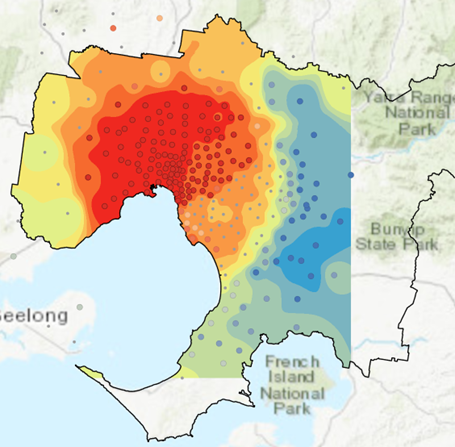
GIS Portfolio: Visualizing Data, Informing Decisions.
Nadia Sharif
Student of Masters of Geospatial Science at RMIT University, Melbourne
Live Melbourne Metro Trains Digital Twin
Live Melbourne Metro Trains - Digital Twin is a full-stack, real-time geographic visualization project that transforms raw public transport feed from Transport Victoria Open Data Portal into an interactive 3D map experience. The infrastructure features an Express.js middleware server responsible for fetching and enriching real-time train locations from the GTFS Real-time API with static GTFS schedule data. This processed data is then delivered to a CesiumJS frontend, where the trains are rendered as dynamic models on a 3D/2D map. This architecture ensures low-latency updates every 20 seconds, creating a functional digital twin that accurately reflects Melbourne's metropolitan rail network.
Interactive Map: New and proposed buildings in Melbourne City
An interactive mapping application developed using MapBox, Javascript, HTML and CSS. It shows all newly completed, approved, under construction and applied for buildings in the city of Melbourne in 3D view. The buildings can be filtered according to their building status. Clicking on a building displays all related data in the form of popup box. The data source is the City of Melbourne Open Data Team, 2024.
ArcGIS Instant App: Crime Rate in Victoria in 2022
An interactive mapping application developed using ArcGIS Pro and ArcGIS Online. The Local Government Area (LGA) boundary are taken from ABS website. Crime data has been taken from Crime Statistics Agency Victoria. Interactive map shows crime rate per 100,000 people using a sequential color scheme in a choropleth map. Two interactive charts show the crime rate and area in square kilometres of each LGA. A customized popup is displayed when clicking on any LGA on map.
How ABN registration varies across Victoria and Melbourne
This project explores where business activity is concentrated across Victoria, Australia using ArcGIS Pro. Using bulk data of Australian Business Numbers (ABNs) and 2021 Census population data at the postcode level, I have identified broad regional patterns of economic activity.
Spatial statistical methods like Moran's I and Getis-Ord Gi* were applied to uncover insights. The findings show a clear pattern: inner Melbourne areas are "hotspots" of business activity, while outer metropolitan areas are "cold spots." I also found that different types of businesses have distinct distributions; for example, Public and Private Companies are highly centralized, while Sole Traders and Family Partnerships are slightly more spread out in inner suburbs. This analysis also identified unusual areas (outliers) with exceptionally high or low business densities.
This project demonstrates the power of spatial analysis to reveal economic trends and geographical concentrations within a region.
GNSS Game Pitch
Become a city planner tasked with battling climate change and cooling a bustling city. Plant trees, create green spaces and implement eco-friendly solutions to reduce the urban heat island effect and improve air quality.
Interactive Map: Off-Street Car parks in Melbourne City
An interactive mapping application developed using MapBox, Javascript, HTML and CSS. Users can select an area of Melbourne City to zoom in and view all different types of off-street parking. Graduated circle symbols are used to denote number of car spaces in a car park. Users can filter according to types of car parks and more details are shown using popup boxes. The data source is the Off-street car parks data from City of Melbourne Open Data Team, 2024.
Creating maps using Python Notebooks and GeoPandas
Python has powerful libraries like GeoPandas that can handle large amounts of data to create maps. This example uses Geopandas to read postcode geometry of all postal codes in Australia and then generate maps for each state, showing postcode with the biggest areas in sq.km using appropriate projected coordinates
The result is a series of visually appealing maps and charts that are generated on the fly.
Analyzing increase in house prices in Victoria by LGAs from 1992 to 2022
This examples uses Python and GeoPandas to analyze how much house prices have increased in Victoria from the year 1992 to 2022. The mean house price data of each LGA has been obtained from Victorian Government. The final visualization is an interactive map made using folium.
Static Map: Commercial Off-Street Car parks in Melbourne City
This is a static map created using ArcGIS Pro and Adobe Illustrator. It shows how the number of off-street commercial carparks have decreased over the years in Melbourne City. In the line graph, you can clearly see the trend of decreasing number of off-street commercial carparks and increasing number of off-street residential carparks. The data source is the City of Melbourne Open Data Team, 2024. The task was to extract an interesting story by analyzing Off-street carparks data and tell it though a one-page static map.







